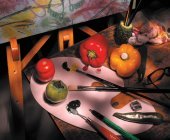|
Color temperature in photographyColor temperature in photography is a quality and characteristic of light source. Actually it has nothing to do with the heat or temperature.
As we see the same color in different light differently, film and digital image sensor also do the same thing. In a bright day light, we see a hue of green as one particular shade but the same green color in tungsten or bulb light looks different. This is because of difference in color and temperature of the light. When this black body is at room temperature, it will not emit any light. When it is heated above 1000 degree, it will start glowing. Initially it will produce dim red, but as the temperature is increased in the range of 3000 to 4000 degree, it will emit yellow light. Upon further heating, at 5500 degree it will be white-hot. The quality of emitted light is equivalent to that of a day light. When it reaches beyond 10,000 degree, it will emit blue light.
1200 to 1500K - Candle light 2400 to 2800 K - 40 W incandescent bulb 3200 K - Sunrise/sunset 3400 K - Tungsten bulb 4500 to 5000 K - Tube light 5500 K - Sunny daylight at 10 am and 4 pm 5500-5600 K - Electronic flash light 6500-7500 K - Overcast day 9000-12000 K - Blue sky, open shade 14000 K - Mid-day Lower temperatures of color are considered as "warm" colors and higher temperatures are considered as "cool" colors. Films are balanced for particular color temperature. This means that a film, which is balanced for day light will give correct color rendering in day light and a film, which is balanced for bulb light will give correct colors in bulb light. However, if we use a film, which is balanced for day light, in bulb light; then the colors will shift and we will get all over orange an red color cast. Digital camera has a "white balance" setting, which has to be set as per lighting condition. If we are shooting in bulb light, setting at "bulb light" in white balance of the camera will record white as white. If the setting is changed to "flash", then we will get "red" cast and white will become reddish. On the other end, if we are shooting at "flash" setting with flash light, the colors will be recorded correctly, but if we shift the setting to "bulb light", then we will get "blue" cast in the photograph. There are occasions, when we are shooting on a location or in a room, which is lit by light sources, having different color temperatures. Example is a shopping mall, where one light is coming from a halogen flood light and other is coming from a tube light. In such case, we can use a color temperature meter, which will show you the degree Kelvin of the ambiance light. Otherwise, select which source is more important in the composition and set the white balance for that source. Area receiving light from different kind of light source will show shifted colors, but overall appeal will be good. If we want to play safe, then set the white balance on 'auto'. The camera will average out the ambiance light and give a reasonably correct result. We can also use a 'pre' setting, where, we have to set the white balance of the camera with a white reference card. Refer the instruction manual of the camera for how to set 'pre' white balance. This temperature has nothing to do with the intensity or brightness of the light.
Must read: Mired calculations in photography |






